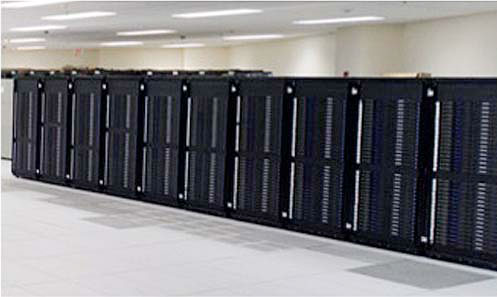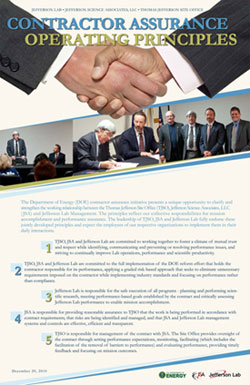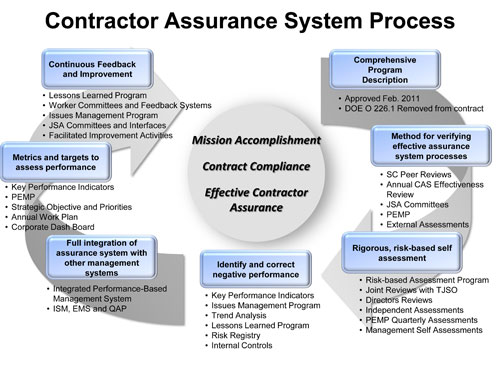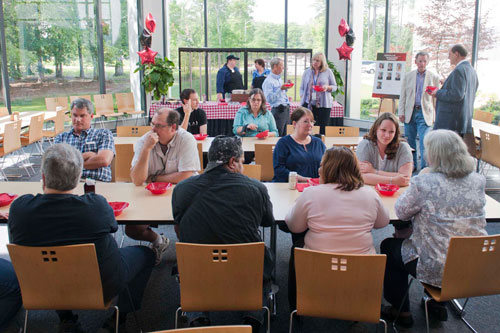
|
June 2011
|
|
|
The U.S. Department of Energy's Thomas Jefferson National Accelerator Facility
|
|
Odd Particle Left Out in the Cold |
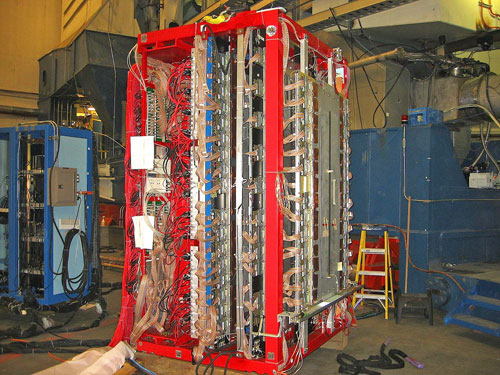
This new, unique detector system was added to BigBite for the running of Experiment E02-013, carried out in the spring of 2006.
The old saying birds of a feather flock together may also be true for the smallest bits of matter. According to a study recently published in Physical Review Letters, like particles inside protons and neutrons band together, leaving the odd one out. Inside every proton and neutron is a triplet of smaller particles called quarks. The neutron has two down quarks and one up quark. In the neutron, it's the down quarks that hunker together, with the up quark getting the cold shoulder. On the other hand, the proton has two up quarks and one down quark. In the proton, it's the up quarks that pal around together, leaving the down quark out...... more |
|
|
Rare Color from FEL Could Enable Research on Extreme Dating and Efficient Diesel
|
JLab, Fermilab, Brookhaven Offer Computing Time to Japan's Physicists
|
Hot Off the Press: Decade of Jefferson Lab Physics Gathered into Journal
|
||
|
|
||||
Below the Fold:
|
||||
Odd Particle Left Out in the Cold |
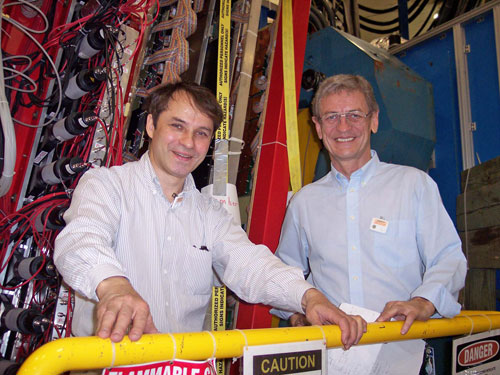
Bogdan Wojtsekhowski, Jefferson Lab, and Guenther Rosner, Glasgow University, taking a break during the experiment's run in 2006.
The old saying birds of a feather flock together may also be true for the smallest bits of matter. According to a study recently published in Physical Review Letters, like particles inside protons and neutrons band together, leaving the odd one out. Inside every proton and neutron is a triplet of smaller particles called quarks. The neutron has two down quarks and one up quark. In the neutron, it's the down quarks that hunker together, with the up quark getting the cold shoulder. On the other hand, the proton has two up quarks and one down quark. In the proton, it's the up quarks that pal around together, leaving the down quark out. "The pair of quarks are bound more strongly than, and are also spread over a much smaller space than, the lone quark," says Bogdan Wojtsekhowski, a Jefferson Lab staff scientist and spokesperson for the experiment. "In the proton, the up quarks are concentrated, and the down is diffuse." The result comes from research that focused on measuring the internal structure of the neutron. Most experiments that investigate the neutron in the nucleus of the atom do so by blowing it apart. The idea is to learn what the neutron looked like by studying the pieces. But this time, researchers delved deep inside an intact neutron, revealing clues about its internal structure. It was the deepest scan of the innards of an intact neutron ever successfully attempted. "This is the first time anyone has looked at the three quarks in the neutron," Wojtsekhowski says. "It is a step to the territory where the three quarks dominate: We should only see three quarks." Studying the neutron is fraught with difficulty, he explains. Pull the neutron out of the nucleus of the atom, and it'll survive for only a few minutes on its own. So, scientists devised a way to set the neutron apart while it's still bound inside the nucleus. In the Jefferson Lab experiment, the researchers studied a unique source of neutrons called helium-3. The nucleus of an atom of helium-3 has two protons and one neutron. Set this nucleus to spinning, and the protons will spin in opposite directions, effectively canceling out. That leaves the neutron to carry the spin of the helium-3 nucleus, clearly setting the neutrons' spin direction. The spinning neutrons were bombarded with electrons from Jefferson Lab's CEBAF accelerator. Some of these neutrons were knocked cleanly out of the nucleus and into a detector for measurement, called BigHAND (the Big Hall A Neutron Detector). Another detector, the BigBite spectrometer, collected and measured the electrons that had knocked neutrons out of the target. "When we probed the neutron in this experiment, it allowed us to look at the three quarks with great clarity. We were probing forces between the three quarks – examining forces that exist before and after the electron-neutron interaction," Wojtsekhowski explains. By combining information gathered from these measurements, similar measurements of the proton and theoretical calculations, the researchers were able to piece together a new picture of how the quarks distribute themselves inside protons and neutrons. "This type of data was impossible to see before this measurement. It was not possible before to see how the pair of quarks behave in relation to the other. We now know how the quarks are distributed in these particles," Wojtsekhowski says. "What we have learned here, is that the dual quarks are more tightly bound than the lone quark." Experiment E02-013 was first approved to run in 2002. The experiment was carried out in Jefferson Lab's Experimental Hall A in the spring of 2006, collecting 125 times more data than previously gathered in similar experiments with a polarized target. More than 100 scientists from 33 institutions worked on the experiment. Wojtsekhowski credits the dedication of his collaborators for the experiment's success. Innovative target design by the University of Virginia researchers, led by Gordon Cates, and unique detector development, led by Nilanga Liyanage, Richard Lindgren and Donal Day, and persistent effort by Albert Shahinyan provided the ingredients for success, along with work to integrate the various systems by numerous engineers. Credit also goes to an army of undergraduates who constructed thousands of connections for BigHAND – the largest dedicated neutron detector - and six diligent graduate students who helped make the experiment happen. By Kandice Carter |
Rare Color from FEL Could Enable Research on
|
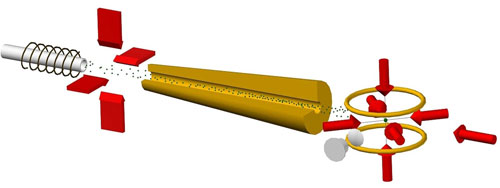
A diagram of an atom trap developed for the purpose of radiokrypton dating.
Image credit: Thomas O'Connor, Argonne National Lab Ancient glaciers, which have long held secrets about early history, could someday reveal their stories to scientists armed with ultraviolet rays. That day drew a lot closer, when on Feb. 28, Jefferson Lab's Free-Electron Laser delivered its first beams of UV laser light into an experimental lab. Many other experimental programs also could benefit from the FEL's new capability. Among them are a select few that require a long-sought, rare color of laser light, called vacuum ultraviolet light (VUV). The FEL recently produced VUV at levels that are 100 times brighter than that generated anywhere else. In early December, the FEL team first measured VUV light in the form of 10 eV photons (a wavelength of 124 nanometers). This color of light is called vacuum ultraviolet because it is absorbed by molecules in the air, requiring its use in a vacuum. The availability of tunable, high-power VUV laser light may revolutionize many lines of research that were previously inaccessible, such as radiological dating and diesel engine design. Counting Kryptons "We do ultra-sensitive trace analysis, which then could be applied to all kinds of applications in the earth sciences: dating old groundwater, dating polar ice and mapping ocean currents. We would use this kind of data to model ocean circulation and map groundwater movement. This research has implications in climate change and water resource management," Lu explained. 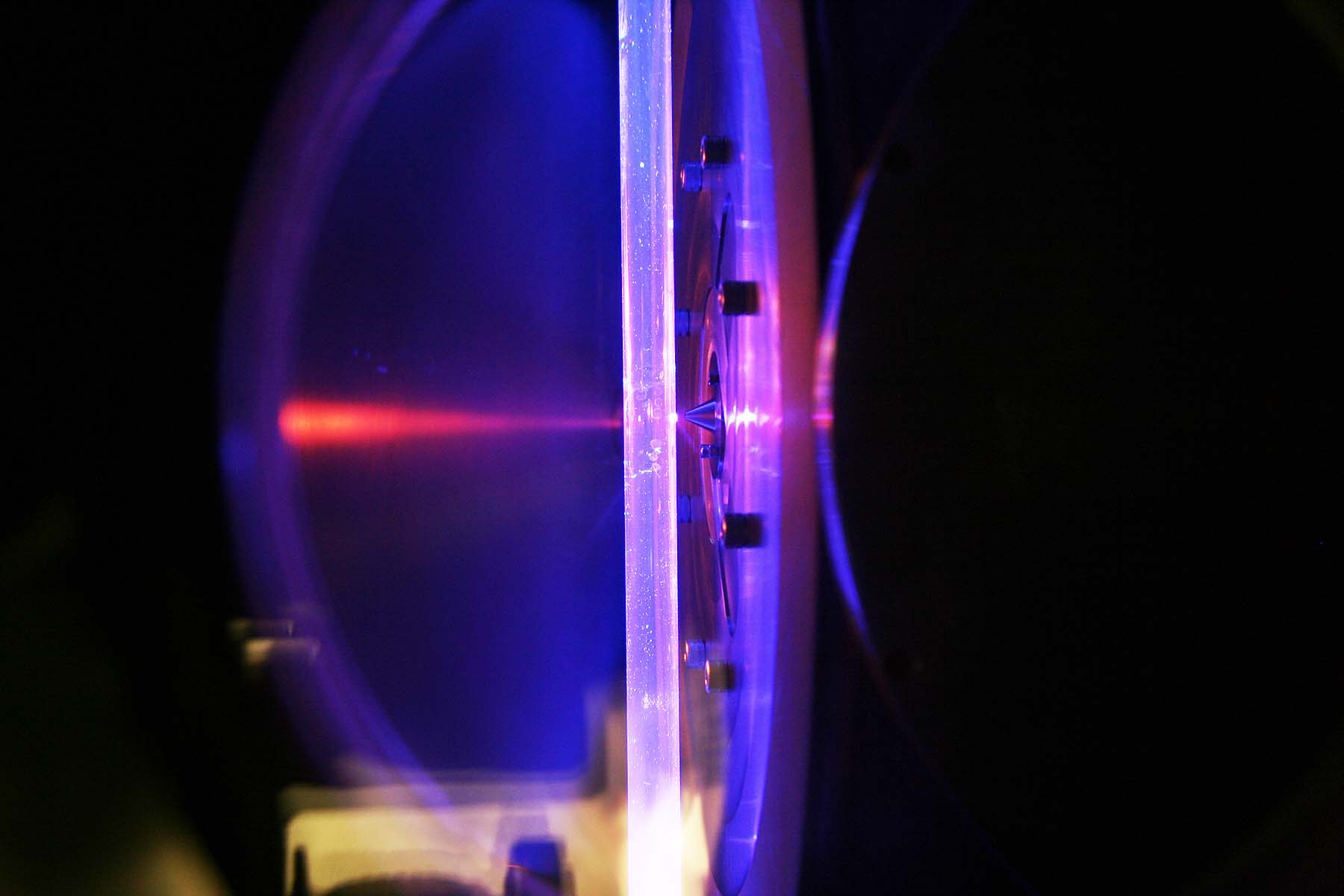
Laser light illuminates the chemical reactor tube in the Multiplexed Photoionization Mass Spectrometer, a unique tool for the study of isomer-resolved chemical reactions. Photo credit: David Osborn, Sandia National Laboratories.
Radiocarbon dating allows scientists to estimate the age of some materials up to roughly 62,000 years. Lu's method uses radio-krypton dating, which could potentially allow scientists to determine the age of materials that are between 100,000 and one million years old. The 10 eV light from the FEL is needed to produce so-called metastable krypton atoms for use in this dating method. Metastable atoms are atoms whose electrons have been given extra energy; scientists refer to this as "exciting" the atoms. These energetic electrons are ordinarily unstable, giving up their extra energy relatively quickly. But giving the electrons just the right amount of energy can make them metastable, so that they hang on to the extra energy a little longer. "In order for us to do the trace analysis that we want, we can only work with atoms in the metastable level, which is about 10 eV above the ground level. With the 10 eV photons from the FEL, we can excite the atoms precisely into that metastable level with very high precision and efficiency," Lu said. Once the atoms are in that metastable level, they're given a little additional energy by an ordinary tabletop laser to "excite" them into a still higher level. Exciting the krypton atoms this one extra step allows them to be caught in a trap and counted one-by-one. The number of krypton atoms present in a sample can reveal the age of the substance. In this way, for instance, scientists can learn about Earth's ancient climate by dating a layer of ice extracted from old glaciers. "Polar ice has been accumulating in Greenland for hundreds of thousands of years. When the ice formed, it trapped ancient air and ancient dust particles. And now ice cores can be extracted and analyzed to learn about the history of Earth's climate," Lu explained. Lu says that the krypton dating method has been proven using other techniques for exciting the krypton atoms. But those methods are not as efficient as the VUV laser light that could be provided by the FEL. "The more efficient we get, then the smaller the sample needed, and the easier it is to apply radiokrypton dating to a wider range of applications. So, I think this VUV laser will be what they call a 'game changer'," Lu concluded. Cleaner Diesel David Osborn is a principal member of the technical staff of the Combustion Research Facility at Sandia National Laboratories. He's studying how fuel is burned in engines. "Combustion is now and will be for many years in the future a primary source of energy conversion in the United States. And so it's in our national interest to use that energy as efficiently as we can and with as few pollutants generated as we can," Osborn explained. Osborn and his colleagues explore the chemistry of how diesel fuel burns. Simply speaking, burning diesel fuel combines with oxygen in the air to yield carbon dioxide and water. Osborn studies the complex process that enables this conversion. "The [fuel] isn't converted in one single step to carbon dioxide and water. Instead, there are many intermediate steps, and the unstable chemicals so formed are called reaction intermediates," he explained. "Our studies try to follow all of these intermediates, providing evidence that helps us understand why one fuel forms more pollutants than another fuel." The research involves starting a chemical reaction inside a vacuum chamber, and then sampling the contents of the chamber as the reaction proceeds. To sample the intermediates, scientists zap individual molecules with VUV light, which removes one electron, making them positively charged. Then, an electric field grabs onto the molecules and sends them into a device called a mass spectrometer, which weighs the molecule to identify it. "We use the 10 eV light, or we would like to use it from JLab, to turn those neutral molecules into positive ions. And then our mass spectrometer can weigh each one of these positive ions," Osborn said. He says that the tunable FEL light is key to the process. It allows the scientists to tune to the color of laser light that will ionize some isomers but not others. The FEL light will provide significantly increased sensitivity to scientists trying to differentiate molecules that weigh the same but have vastly different chemical properties. "Two isomers [can] have the same atoms, but they're arranged in a different order; they weigh essentially exactly the same amount; but chemically, they're very different. And observing one or the other can help you understand the chemical pathways that created them," Osborn explained. "So these could be intermediates in a reaction. And if you saw only one or only the other, you might draw different conclusions about what chemistry made them." Another major benefit to using vacuum ultraviolet light from the FEL is that an intense beam of this color of light will allow the researchers to study reactions important in diesel engines at real-world pressures. "Most of these reactions that we study that are related to combustion – we study them at fairly low pressures, about one-one hundredth of an atmosphere, where one atmosphere is the pressure at sea level on Earth," Osborn said. "But most combustion happens at pressures above one atmosphere. The pressures may be 10 or 20 or 30 atmospheres. The intense photons from the Jefferson Lab Free-Electron Laser should allow us to study reactions at relevant pressures – high pressures – with the same signal to noise we can now do at low pressures using synchrotron radiation." Experimental Machine "We still have a lot of work ahead of us before experiments can begin," said Gwyn Williams, FEL basic research program manager. "But we are ready to begin working with the users to get support so that we can proceed." The FEL program is supported in part by the Department of Defense's Office of Naval Research, the Air Force Research Laboratory and the Joint Technology Office, the Commonwealth of Virginia and the Department of Energy's Basic Energy Sciences under contract No. DE-AC05-060R23177. Key equipment was provided by the Wisconsin Synchrotron Radiation Center and Cornell University. By Kandice Carter |
Hot Off the Press: Decade of Jefferson Lab Physics Gathered into Journal |
|
More than 2,000 physicists have conducted research at Jefferson Lab through the years, slowly adding to mankind's knowledge of the smallest building blocks of the visible universe. Now, the first comprehensive review of this body of research has been made available in the volume, "New Insights into the Structure of Matter: The First Decade of Science at Jefferson Lab." The publication features 14 major scientific research themes, as described by small groups of scientists who were integral to conducting the research. These themes encompass results from nuclear physics research, accelerator research and free-electron laser research. In addition, the publication provides a first-person account of the founding of Jefferson Lab. The journal has been published online at the Institute of Physics' (IOP) webpage at: http://iopscience.iop.org/1742-6596/299/1 The publication will be delivered to Jefferson Lab later this year. |
Two Lab Scientists Win Prestigious Early Career Awards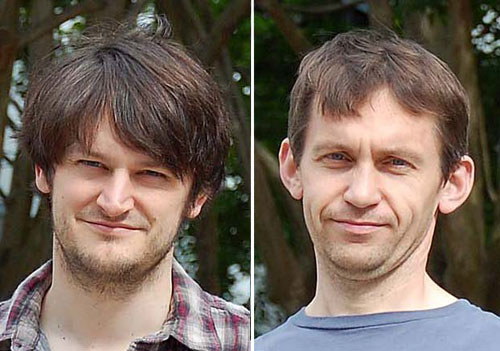
Jozef Dudek (left), JLab Theory Center and Old Dominion University, and Pavel Evtushenko, Free-Electron Laser Division, were among the 65 individuals receiving Department of Energy Early Career Research Program awards.
Two scientists from Jefferson Lab have won highly coveted awards totaling $3.25 million from the U.S. Department of Energy, joining a select group of just 65 individuals, including 21 from national laboratories, to win one of these awards this year. The scientists, Pavel Evtushenko, Free-Electron Laser Division, and Jozef Dudek, Theory Center/Old Dominion University, won their awards under the Early Career Research Program. The program was created last year by the DOE's Office of Science to bolster the nation's scientific workforce by providing support to exceptional researchers during their early career years, a crucial time when many scientists do their most formative work. Evtushenko was awarded $2.5 million to be spread over five years to support his research at the lab's Free-Electron Laser. He plans to develop high-dynamic range diagnostics for linear particle accelerators. Dudek, whose award comes through Old Dominion University, where he is an assistant professor, was awarded $750,000 over five years to support his research of sub-atomic particles known as mesons. Dudek and his colleagues are using supercomputers to predict the structure of mesons, which will be produced and studied at Jefferson Lab following the lab's 12 GeV Upgrade. "To win these prestigious awards speaks highly of the outstanding work done by Pavel and Jozef and to their future contributions," said Hugh Montgomery, the director of Jefferson Lab. "All of us at the lab are extremely proud of these two young scientists, and we look forward to sharing in the discoveries they may make." To be eligible for an Early Career award, a researcher must be an untenured, tenure-track assistant professor at a U.S. academic institution or a full-time employee at a DOE national laboratory and the researcher must have received a Ph.D. within the past 10 years. This year, 1,150 university- and national laboratory-based scientists applied. Winners were selected based on peer review by outside scientific experts. "To say that it is exciting to win this award would not really explain how it feels. Electrifying seems to be a better word, but that might be because of what we do at the FEL," Evtushenko said. "I firmly believe that I could not have written my proposal had I not been at the JLab FEL working with the people here. It is our working together combined with our experience and some forward thinking that resulted in the proposal. I am happy to give something back to the group and the facility, and to contribute to moving us forward to a next-generation light source. Most important to me now is to take advantage of this opportunity and to do good work. This is what I will concentrate on." "It's always encouraging to have your work recognized as important, and this funding award is ideally timed to support our research efforts in preparation for the 12 GeV upgrade," Dudek said. "I couldn't have done this without the support and advice of my collaborators: Robert Edwards, David Richards, Christopher Thomas and Balint Joo at the lab and Mike Peardon at Trinity College Dublin." When asked how he would advise other early career researchers interested in applying for grants, he said, "The advice I would give to early career researchers applying for grants is mostly the obvious stuff," Dudek said. "Do good, relevant and somewhat unique research. If you work collaboratively, take a leadership role. Regularly communicate with those for whom your research is relevant through papers and talks, making sure to talk to both theorists and experimentalists. Propose to do work that is challenging, but not 'too' risky, and be persistent. If your proposal gets rejected apply again next cycle." The DOE announced the awards in May. This year's applicants were described as "phenomenal" by Linda Blevins, lead program manager for the DOE Office of Science Early Career Research program, in an email to the national lab directors. "We could not be more thrilled with the newest group of selectees," she wrote. More information is available at the Department of Energy website at: http://science.energy.gov/early-career/ Research Abstracts: The goal of this project is to advance the development of large-scale LINAC (linear particle accelerator) based fourth-generation light sources with high average current by gaining an understanding of electron beam halo formation processes and developing methods to control the halo. The project aims to develop beam diagnostic techniques for characterization of the electron beam parameters with dynamic range much higher than used now. One goal is the measurement of the longitudinal and transverse phase space distribution with a dynamic range of about 106. Such measurements will be used for experimental investigation of halo formation and its evolution through the accelerator. Another goal is to develop beam optics solutions to control and manage the beam halo such that it would not be a limiting factor for the next-generation LINAC based light sources. The program also aims to benchmark machine design codes in terms of their ability to describe the beam halo evolution. It is envisioned that better understanding of halo formation and evolution will contribute significantly to the performance of future light sources. This research was selected for funding by the Office of Basic Energy Sciences. Jozef Dudek - Meson Spectroscopy from Quantum Chromodynamics (selected by the DOE's Office of Nuclear Physics). The basic building blocks of the atomic nucleus, protons and neutrons, are constructed from quarks, bound together by gluons in such a way that they are never seen in isolation. Quarks and their anti-particles can also pair up in short-lived states called mesons; the goal of this project is to predict the theoretical properties of these mesons. Although we know the fundamental theory of quark and gluon dynamics to be solved, "Quantum Chromodynamics" (QCD), exact mathematical solution of the theory eludes us. Our best available tool for studying QCD is "Lattice QCD" (LQCD), a numerical solution of the theory with controllable approximations. This research project will use novel LQCD techniques to predict the masses and quantum numbers of mesons, their internal quark-gluon structure, their decays into other mesons, and their couplings to photons. A major emphasis will be the predicted properties of "hybrid mesons," hypothetical exotic particles in which the usual quark-antiquark pair is accompanied by an excitation of the gluon field that binds them. This project will complement a planned search for hybrid mesons by the Gluonic Excitation Experiment (GlueX) at the Thomas Jefferson National Accelerator Facility. This research was selected for funding by the DOE Office of Nuclear Physics. Jefferson Lab, JSA, DOE Implement Contractor Assurance SystemAt the request of the U.S. Department of Energy, each of the national laboratories has instituted a new and comprehensive management oversight program. The laboratories developed and are in the final stages of implementing this new program in coordination and cooperation with their respective management and operations contract organizations and their DOE site offices. The requirement, instituted in December 2009, is called the Contractor Assurance System. The program is tailored around the mission and goals of each laboratory and its purpose is to "provide reasonable assurance that the objectives of the contractor's management systems are being accomplished and that the systems and controls are effective and efficient." Over the course of many months starting early in 2010, Jefferson Lab management and staff worked closely with Jefferson Science Associates' management and members of DOE's Thomas Jefferson Site Office to put the final touches on the Contractor Assurance System, according to Mike Dallas, JLab's chief operating officer. The result is a structured program laid out in a document titled the "Contractor Assurance System Program Description for the Thomas Jefferson National Accelerator Facility." It states that "assurance is designed to enable mission accomplishment; protect workers, the public, and the environment; and foster the efficient and effective functioning of operational, facility, and business systems while meeting applicable contract requirements. The outcomes of the CAS serve the needs of DOE by providing reasonable assurance that these objectives are met." The Contractor Assurance System is predicated on the following principles:
A Contractor Assurance System Peer Review was conducted at Jefferson Lab April 12-14. The objectives of the review were to determine the extent to which JLab's CAS is consistent with the DOE Office of Science Assurance Program description; to evaluate the maturity of the lab's system in terms of functionality, effectiveness and efficiency, and to offer feedback for improvement. A team of six composed of DOE and representatives from other DOE laboratories conducted the review. Anita Gursahani, University of California Office of the President and review committee chair, remarked during the review closeout on how fortunate the lab is to have a strong level of support in the local community and across the Commonwealth. Commenting on JLab's CAS, she noted, "The level, variety and frequency of communications between JSA, TJSO and JLab is impressive and supports transparency and builds trust. … All key elements are in place and functioning properly." Over the next several months, Jefferson Lab will be working with TJSO to fully implement the recommendations from the peer review, according to Dallas. Members of the JSA Board of Directors, including the owner representatives SURA President and CEO Jerry Draayer and CSC/ATG President Alan Weakley, participated in the review. Draayer and Weakley noted that the peer review validated a strong and effective governance model where JSA plays a key role in the tri-party partnership, bringing much value to JLab and to the DOE. Draayer believes that "the series of CAS reviews across the Office of Science is helping to reinforce the understanding that a strong DOE-contractor-laboratory partnership will bring out the best in our national labs and thus enable them to achieve mission success." TJSO staff members were integral participants in the April review as well. TJSO Manager Joe Arango pointed out that the CAS progress being made across the Office of Science is currently supporting even broader reforms across all of DOE to improve mission execution outcomes. A portlet has been set up on the Insight Front Page to provide managers and everyone at Jefferson Lab with access to the lab's CAS program description, background information, the tri-party Operating Principles agreement and the results of Contractor Assurance System Peer Review. JLab, JSA, DOE Ratify Operating Principles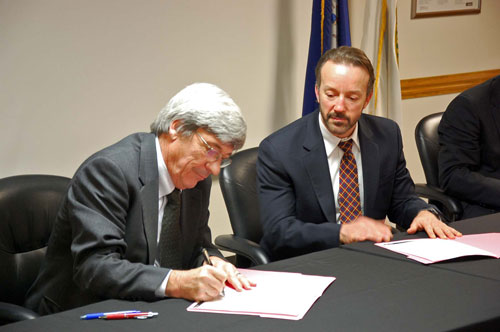
The Contractor Assurance System Operating Principles were jointly signed by Jefferson Lab Director Hugh Montgomery, then TJSO Acting Manager Scott Mallette, JSA Board of Directors Vice Chair and SURA President Jerry Draayer and JSA Board of Directors Vice Chair and CSC-Applied Technology Group President Alan Weakley. Here Montgomery (left) signs the document while Mallette looks on.
A new set of operating principles has recently been jointly ratified by Jefferson Lab, Jefferson Science Associates leadership and the Department of Energy's Thomas Jefferson Site Office. The principles were developed under the DOE contractor assurance system initiative, which promulgates steps to clarify and strengthen the working relationship among Jefferson Lab, its management and operating contract organization (Jefferson Science Associates, LLC,) and the DOE's Thomas Jefferson Site Office. The principles reflect the three parties' collective responsibilities for mission accomplishment and performance assurance. The leadership of TJSO, JSA and Jefferson Lab fully endorse these jointly developed principles and expect the employees of our respective organizations to implement them in their daily interactions, according to Mike Dallas, JLab's chief operating officer and a primary participant in the development of the program at the lab. The first principle commits the parties to fostering a climate of mutual trust while working together to prevent or resolve performance issues and make continual improvements. The second statement charges the parties to fully implement the DOE reforms that hold the contractor (JSA/JLab) responsible for its performance, and seeks to eliminate unnecessary requirements imposed on the contractor. The third charge holds Jefferson Lab responsible for the safe execution of all programs while meeting performance-based goals established in the contract. The fourth pronouncement underscores JSA's responsibility to assure DOE that all aspects of the work performed at Jefferson Lab is in accordance with the contract. The final principle frames the responsibilities of the TJSO. The document was jointly signed by Jefferson Lab Director Hugh Montgomery, then TJSO Acting Manager Scott Mallette, JSA Board of Directors Vice Chair and SURA President Jerry Draayer and JSA Board of Directors Vice Chair and CSC-Applied Technology Group President Alan Weakley. "The principles have been developed, with variations, across the Department of Energy national laboratory system. We are here to put a marker on what is a developing process that Secretary [of Energy Steven] Chu envisioned to influence how we administer and manage ourselves," said Lab Director Hugh Montgomery in his opening comments. "One of the initiatives he has strongly encouraged is the contractor assurance system. "Using Quality and ES&H principles, it directs line managers to take responsibility for performance… [and] is being translated into a system or method of operation for the national laboratories. "As part of that we've developed a document that lays out the relationship between ourselves and the Site Office and our corporate ownership. We started this process nearly a year-and-a-half ago," Montgomery said. "This effort has depended on a lot of people from all three entities." "Many participated in this unique opportunity to solidify these key principles," added Scott Mallette, TJSO's then acting manager. "Principles that provide a good framework for us to work from and help emphasize the importance of transparency, working together and identifying and removing obstacles to progress. I think we are headed down a bright path." Planning for the Future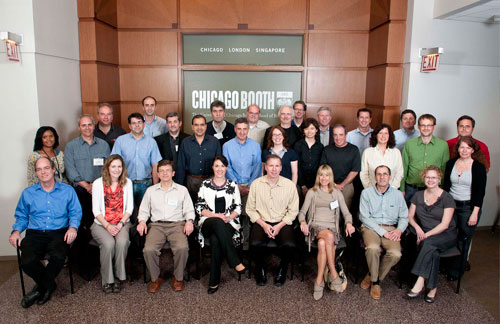
The Strategic Laboratory Leadership Program (SLLP) is a leadership program developed and offered by the University of Chicago Booth School of Business Executive Education Office for employees of Argonne National Lab, Fermilab and Jefferson Lab. The current class included five JLab staff members. Pictured in the bottom row, left to right, are: Mark Jones (J), Betsy Grom (A), Dmitri Denisov (F), Leah Guzowski (A), Tim Currie (F), Fulvia Pilat (J), Paul Zschack (A) and Beth Cerny (A). Pictured in the middle row, left to right, are: Valena Sibley (F), Bob Sperlazza (J), Aymeric Rousseau (A), Daniel Lopez (A), Rajeev Thakur (A), Ioanis Kourbanis (F), Corrie Clark (A), Julie Whitmore (F), Rob Roser (F), Jolie Macier (F), Stefan Vogt (A), Mike Bevins (J) and Marcia Woods (A). And in the top row, left to right, are: Axel Hoffmann (A), Arkadiy Klebaner (F), Gueorgui Velev (F), Hubert Ley (A), Erik Gottschalk (F), Devin Hodge (A), Jeff Chamberlain (A), Brad Ullrick (A) and Bill Rainey (J). (J - Jefferson Lab, A – Argonne, F – Fermilab)
When asked a challenging question by a group of inquisitors about the future direction of the Department of Energy, Under Secretary Steve Koonin leaned back in his chair and paused before providing a detailed answer. He then turned the tables and asked his inquisitors what they would do to improve the future course of the department. Although typically quizzed on such issues by members of Congress, Koonin's questioners in this instance were Jefferson Lab staffers, including a group participating in a unique training program, known as the Strategic Laboratory Leadership Program. SLLP is a non-degree executive education leadership program developed and offered by the University of Chicago Booth School of Business Executive Education Office to employees of Argonne National Laboratory, Fermi National Laboratory and Jefferson Lab. The SLLP curriculum includes three intensive sessions with Chicago Booth faculty on such topics as business strategy, long-range planning, implementing innovation and communication. Participants are also divided into groups and given an assignment that culminates in each group making a presentation to upper management from Argonne, Fermi and Jefferson Lab. The face-to-face meeting with Koonin in June at CEBAF Center provided Jefferson Lab's SLLP participants with a unique opportunity to gain some high-level insight as they prepared for this year's group assignment – developing a presentation for delivery to a "congressional committee or group of influential citizens that presents a convincing message for the value of basic research in our national labs." "Interesting meeting," said Bill Rainey, from the ESH&Q Division. "I feel that the Under Secretary really opened up and shared his perspective on some of the issues faced by DOE. It gave us plenty to think about and to share with our groups as we prepare our presentations." In addition to Rainey, the other JLab staffers participating in this year's program are: Fulvia Pilat, Accelerator Division; Mark Jones, Physics Division; Bob Sperlazza, Facilities Management & Logistics department; and Mike Bevins, Engineering Division. All were selected by senior leadership, after it was determined that they met the program's basic requirement that they demonstrate "exceptional work in key mission areas, formal or informal leadership abilities, capability to work collaboratively, ability to work effectively across traditional laboratory boundaries, and innovation and creativity in problem solving." This is the second year that the lab has participated in SLLP. Those who participated in last year's inaugural program for the lab were: Will Oren, Engineering Division; Arne Freyberger, Accelerator Division; Latifa Elouadrhiri, 12 GeV Upgrade project; Kari Heffner, Information Technology Division; and Doug Higinbotham, Physics Division. "I would classify the instructors at SLLP as world class, the material is first rate and the interaction with Fermi and ANL staff as quite valuable," Oren said of his experience. While preparing future leaders for the lab, SLLP also helps the lab meet one of the key objectives of its Performance Evaluation and Measurement Plan, or PEMP. Jefferson Lab's PEMP requires that the lab develop succession planning for senior leaders. "The Strategic Laboratory Leadership Program is an outstanding program, and it is providing real value to the lab and to those individuals selected to participate," said Mike Dallas, Jefferson Lab's chief operating officer. "Those who undergo this training are learning new and better ways to manage our laboratories, which will benefit our nation in the pursuit of its scientific mission and goals." Worker Safety Committee Provides Forum for Unresolved Safety ConcernsWorkers looking for a group to represent their concerns about safety issues at Jefferson Lab have an ally in the Jefferson Lab Worker Safety Committee. For the past decade, the 10-member committee has met monthly to discuss unresolved safety issues from across the laboratory. "Everyone at the lab is empowered on a daily and routine basis to deal with safety issues at any time, in any situation," points out Marcy Stutzman, chair of the WSC. "Everyone knows that they can take any type of safety concern or question to their Safety Warden or a Subcontracting Officer's Technical Representative (SOTR). The WSC exists specifically to address safety issues that, for one reason or another, have not been mitigated at that local level." Being a member of the WSC is voluntary and requires no special training. WSC responsibilities are added to each member's regular work duties. The members are all non-management employees and are from every major division in the lab. 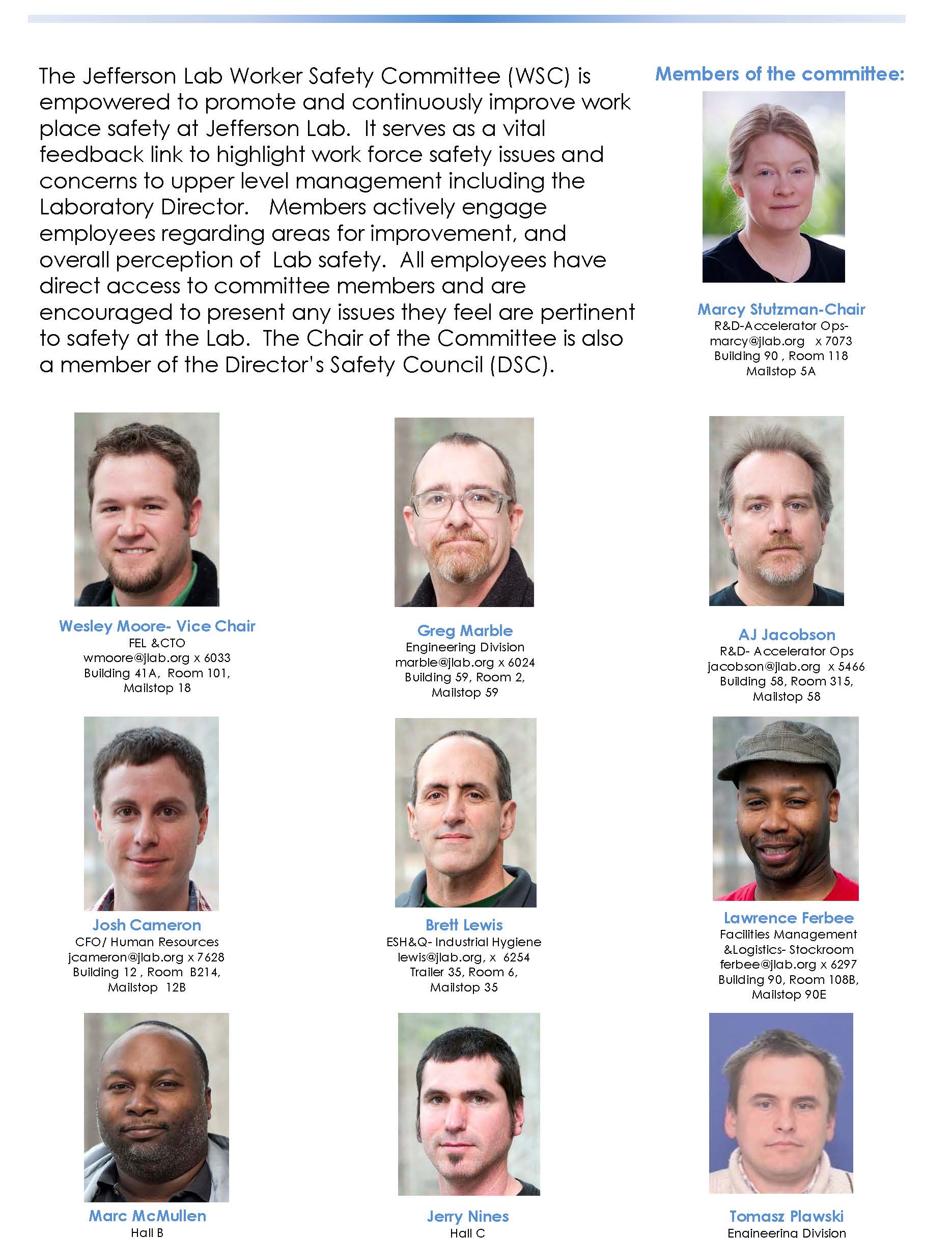 The Worker Safety Committee At a Glance The Worker Safety Committee At a GlanceAccording to the Worker Safety Committee's charter, it is empowered to promote and continuously improve work place safety at JLab. The committee provides laboratory management with working level feedback, ideas and recommendations for improving safety lab wide. The committee also provides safety stakeholders – employees, subcontractors and users – with the opportunity for communication of their issues and concerns. The committee is not intended to bypass existing procedures and processes. Rather, it serves as a vital communication link for highlighting workforce safety issues and concerns and as a means for addressing actions of interest to the workforce. Committee members actively seek employee, user and subcontractor input regarding strengths, areas for improvement, and overall perception of lab safety. The committee has direct access to the Director's Safety Council, the Jefferson Lab director and other lab safety groups anytime necessary. Committee members are selected by their peers for a two-year term. Terms are staggered intentionally so that the group's collective knowledge isn't lost and flows naturally from year to year. Fixed, rotating terms also provide a way for members to take the enhanced safety mindedness they gained on the WSC back to their divisions and to the lab community at large. Stutzman, an Accelerator Division staff scientist, was nominated to the committee a year ago, and has been chair for the past several months. Vice-Chair Wes Moore, a computer scientist at the Free-Electron Laser, is in his third year on the committee; his term was extended when he was elected to his current position. The WSC chair sits on the Jefferson Lab Director's Safety Council, which meets quarterly. Upper lab management, including Director Hugh Montgomery, is invited to every WSC meeting. "We have our committee meeting first, and then upper management is invited to join us. Associate Director for Environment, Safety, Health & Quality, Mary Logue, sometimes brings issues to us," Stutzman notes, and Montgomery often attends as well. In fact, his presence at the meetings was one of the things that impressed Moore the most when he first joined the committee. "It was a real eye-opener to see the involvement of management," he says. "He not only attends, he's very involved in our discussions." It is intentional that the WSC members are non-management-level employees. "We are the voice of the workers," Moore says emphatically. Each member's role on the WSC goes far beyond monthly meetings. They are available by phone or email at any time for an employee who has a safety concern that's not been satisfactorily resolved. "We can often get a new concern addressed well before our next meeting," Stutzman notes. In an effort to increase the committee's visibility, a new poster has been made that provides a photo of each WSC member and their contact information – making them easily recognizable and easy to contact. The posters, Stutzman and Moore say, are really working in terms of enhancing WSC visibility around the lab. The WSC also serves as something of a clearinghouse for members to explain how safety issues have been solved and resolved in their respective divisions. "Because the lab is large and spread out, many of us don't have the opportunity to discuss these issues otherwise. This is a very effective way for us to share lessons learned and keep others from having to 'reinvent the wheel,'" Stutzman explains. The intent of the WSC is to address safety issues or concerns that have not yet been worked out. The committee only deals with issues of safety. The meetings are for WSC members and invited guests – people with concerns should approach the members of the WSC to bring their issue to the committee. Over the last couple years it's no surprise that construction and traffic issues have been among the hot topics the committee has dealt with, among them the lighting along Lawrence Drive and the new traffic pattern at the Accelerator Site entrance. "I like that we try to provide common-sense solutions," Moore added, "not a million-dollar fix to things that are a problem right now. Our work aims to be simple and cost-effective through our own brainstorming." The WSC webpage is at: http://www.jlab.org/ehs/wsc/ . The minutes from WSC meetings are available on Docushare, at: https://jlabdoc.jlab.org/docushare/dsweb/View/Collection-1828 . By Judi Tull JLab Welcomes Students, Teachers for Summer Programs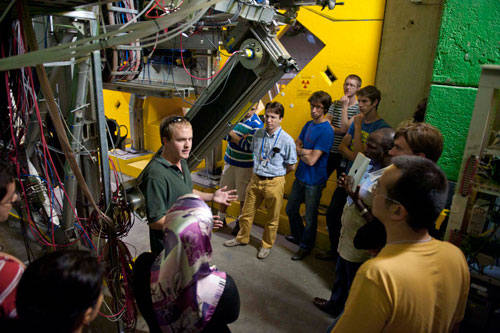
John Leckey, a graduate student at The College of William and Mary, discusses the Qweak installation in Hall C with the Hampton University Graduate Studies program participants. The group toured JLab on June 2.
While schools across the country are winding down for the summer, the education programs at Jefferson Lab are just now kicking into high gear. The number of high school students, college undergraduate and graduate students and teachers at the lab climbs significantly during the summer as a large population comes to participate in a variety of innovative, educational, science-based programs. The first to arrive, on May 23, were 15 undergraduates participating in the Department of Energy's Science Undergraduate Laboratory Internship program and an additional 12 are participating in Research Experiences for Undergraduates program. Eight of the REU students are from Old Dominion University and four are from Hampton University. REU programs are funded by the National Science Foundation. The lab's Science Education office handles the logistics (travel to the lab, residence, training, etc.) for both SULI and REU programs. These programs run from May 23 through July 29 and are geared toward undergraduates who are pursuing careers in science or technology. The 10-week internships are designed to support the intellectual and professional development of students who have a sincere desire to be fully involved in a program that offers an intensive, mentored, scientific research experience. Each student is assigned a project and a mentor as part of the internship, and completes a paper and prepares a presentation poster on the research project. On June 20, six rising juniors and seniors arrived for the six-week JLab High School Summer Honors Program. HSSHP gives students the opportunity to work with mentors in scientific or technical areas of the lab. Students chosen for these positions are strong in math, science, and/or computer science and are interested in pursuing math, science, physics, computer science, engineering, or other technical careers. The program provides professional mentoring and experience in a science-research environment. Students are assigned a project and complete a paper and prepare a presentation poster on their work, and take part in activities across the laboratory, including accelerator engineering, experimental research, free-electron laser projects and computer programming. Beginning on June 27, 11 elementary and middle school teachers of science will participate in JLab's summer, teacher enrichment program. The four-week program offers a course in basic chemistry, guest lectures on current research by Jefferson Lab staff, workshops on improving physical science instruction at the elementary and middle school levels, and team-based hands-on explorations under the guidance of JLab staff. The purpose of the program is to enhance physical science instruction at the elementary and middle school levels, according to Jan Tyler, JLab's Science Education program manager. The goals of the program are to enhance teacher content knowledge and skills, including leadership skills; increase teacher awareness and ability to communicate with their students about current issues in science and technology; build teacher competence and confidence by offering teachers an opportunity for revitalization and recognition; and support the inclusion of each teacher as a valued member of the professional science and technology community. The HSSHP, SULI and REU student programs run through July 29. They will share their research experiences during a poster session on Friday, July 29. The poster session will take place in the CEBAF Center lobby from 11:45 a.m. to 2 p.m. and is open to the entire JLab community. "The poster session is an excellent opportunity to see and hear about some of the great work the students have tackled over the summer," Tyler adds, "and to encourage them at this critical time in their education process and professional development." In addition to these programs run by Science Education, JLab also hosts the Hampton University Graduate Studies program, which ran from May 31 to June 17. This marked the 26th consecutive year for HUGS – a summer school designed for second and third year experimental or theoretical nuclear/particle physics graduate students who have finished (or nearly finished) their coursework. The program is funded by a grant to Hampton University from the DOE's Office of Science and through monetary and labor support provided by JLab's Theory Center. HUGS focuses primarily on experimental and theoretical topics of high current interest in strong interaction physics. Thirty-seven grad students from universities in Virginia and across the U.S. as well as students from Belgium, Canada, Germany, Italy and the United Kingdom participated in the program. The school is described as intensive, but friendly and casual, and provides students with opportunities to interact with internationally renowned lecturers and JLab staff, as well as with other graduate students and visitors. Thia Keppel, JLab/HU, is the HUGS program director, while Alexei Prokudin and Mary Fox of the Theory Center, served respectively as coordinators for science and school support. Publish Your Work: It's Good for You and JLabThe experiments and work conducted at Jefferson Lab produce information. This information can take many forms, including data and papers presenting experiment results, posters or talks for conferences, journal articles, designs for new types of equipment and systems, papers presenting or analyzing theories, dissertations, technical notes and reports, video and audio presentations, and even patent applications. All of it demonstrates the output or value of the work done at the lab, according to Kim Kindrew, JLab records manager and administrator of the Publications Management program. Documents authored by JLab staff or based on data from experiments conducted at JLab that will be published in professional journals or conference proceedings need to be submitted to Jefferson Lab's Publication Management system. "After getting it written," Kindrew says, "the most important thing the lead or corresponding author needs to do is upload it into the Publication Management system. Any file in any format generated from research conducted at JLab or a JLab technological development that is intended for public distribution or publication must go through this process." Loading the document into the system initiates the review and approval process needed before the information can be published or presented, or posted to a public scientific archive system like arXiv.org. The process varies somewhat by division, and specifics are posted online at: https://www1.jlab.org/ul/publications/help/flow_of_approval.cfm. In addition, if the document contains proprietary information, intellectual property or export-controlled information, the corresponding author must have the lab's Legal Office and possibly other offices review the document. To start the process, visit the Publications tab on the Information Resources webpage to submit the paper for review. The logging in link on the Publications page allows members of the JLab community to submit papers for internal peer review and approval, and to prepare it for professional publication. "A review can pick up typos and grammar problems and even the occasional mistake or incorrectly cited reference," Kindrew notes. "This makes the final publication much more professional looking and reading – and ultimately more credible." After a paper has been reviewed and approved, the author is encouraged to upload it to arXiv.org based at the Cornell University library. ArXiv is an e-print service that includes the fields of physic including accelerator physics, mathematics, non-linear science, computer science, and other fields. Submissions to arXiv must conform to Cornell University academic standards, and a JLab review helps to ensure that it meets those standards, Kindrew explains. However, if the author(s) are submitting the paper to Science and/or Nature, they may decide to delay uploading the paper to arXiv. If the paper (its data, results or analyses) could be of interest outside of the nuclear physics research community, the corresponding author or one of the collaboration's spokespeople should contact Kandice Carter, JLab science writer, at kcarter@jlab.org or call ext. 7263. Currently, Technical Notes may be emailed directly to Kindrew at kindrew@jlab.org , for posting into the Tech Notes folder on Docushare. Anyone physically at JLab may sign into their JLab computer account and access the Tech Notes at: https://jlabdoc.jlab.org/docushare/dsweb/View/Collection-1419 . A variety of technical documents, dated from 1985 to the present, are available in pdf format. The review submission process isn't difficult, Kindrew notes, but may be confusing for first-time authors or for individuals who haven't submitted a paper or other type of publication in recent years – be they staff, users or students. To help familiarize individuals with the review, approval and publication process, Kindrew has begun offering quarterly Publication Refresher training. The next session will be held Tuesday, July 12, from 9 - 10 a.m. in CEBAF Center Room F228. Staff, users and students are invited to attend. Send an email to Kindrew before July 8 to sign up for the session. "Getting research results, theory papers, dissertations and technical advancements to the broadest audience possible is good for the authors and for the lab," she explained. "It all demonstrates the lab's status as a world-class physics research institution. As those papers are cited, and their authors referenced or asked to speak at conferences, the more visible and important the work here becomes." It also makes the knowledge more accessible for possible licensing and commercialization, which is a lab and DOE priority, she noted. "Advancing and publishing scientific research and knowledge enhances our status as a world-class institution and has a positive influence on future funding," explains Roy Whitney, chief information and technology transfer officer. "Publishing and documenting the published work including when and how it is cited, demonstrates that Jefferson Lab is conducting world-leading research and having scientific impact." Documents or other articles written for public distribution, whether they are based on research papers or not, must be reviewed by the Public Affairs office before being sent for publication. This includes documents or articles intended for CERN Courier, ILC Newsline, symmetry and other forms of news reporting. Public Affairs may be contacted via email at: jlabinfo@jlab.org. Beware: Phishing Captures the Social ButterflySocial engineering is the most common method currently being used by hackers to access information and systems. Social engineering focuses on deceiving computer users to circumvent the policies, procedures and hardware safeguards in place to keep hackers out. The security of both Jefferson Lab's systems and your personal computer depends on each being aware of social engineering techniques and avoiding actions that will allow an intruder access, according to Bob Lukens, Cyber Security manager. Here are some tips to help thwart social engineering attacks: -- Remember that Computer Center staff won't phone or email you to ask for your computer user account login information. -- Beware of "phishing" phone calls or emails. Do not give confidential, account or other sensitive information to anyone that is unknown to you via phone, email or through a separate web page. -- Don't click any links embedded in an email with a hidden web address or an address that does not match the visible web address. One DOE lab was hacked when computer users clicked a link with a hidden web address. The hidden link went to a web address different from the one presented in the link. -- If the link is in an email that you expected to receive, it is still safer to "cut and paste" the link from the email and into a new web browser window. You can reveal a hidden link's web address by reading your email in plain text (no html encoding) or through viewing the source code of the email. -- Don't open any email attachments that are suspicious (unknown sender, unexpected email with an attachment, or from an email address you haven't gotten mail from in some time, etc.). -- Don't use a CD or memory stick from an unknown source or that you received unexpectedly. For example, one DOE lab was successfully attacked when a staff member inserted an official-looking CD that arrived in the mail into a computer. -- Beware of ecard greetings. If you do not recognize the sender's address, or if the card comes from "a friend" or "a secret admirer," or if it's from a website that is unfamiliar to you, it's almost certainly a scam. If you do recognize the sender, confirm that the card was sent by them. If you are unsure about any ecard you receive, the most secure thing to do is to ignore it. -- Keep your anti-virus software, patches or other security measures up to date, but understand that these are not absolute protection for your system. Scammers are experts at getting around all types of automated security measures. You are the last, best line of defense against viruses, Trojans and scams. When in doubt, delete emails or electronic media and hang up on phone requests that make you suspicious. If you have any doubts about a request received by email or phone, contact the HelpDesk, ext. 7155, to make sure it is valid before submitting any confidential information. If at any time you have provided information through these means but have become suspicious as to the nature of the request, contact the HelpDesk with details of the interaction. JLab Recognizes Staff Members With Service Awards
One hundred twenty-three Jefferson Lab employees attended Service Awards events in May; the events recognized staff members achieving 5-, 10-, 15-, 20- and 25-year milestones.
More than 120 staff members were recognized for their years at Jefferson Lab, during a series of annual Service Awards events held during the first week of May. A total of 123 Jefferson Lab employees attended these events and were recognized for achieving 5-, 10-, 15-, 20- and 25-year milestones, according to Josh Cameron, administrative assistant for Human Resources. The combined total worked by this year's Service Awards recipients was 1,780 years. The awards recipients and their respective supervisors attended the events that were hosted by laboratory leadership and planned by Human Resources. Each event was held in CEBAF Center. An ice cream social was held May 2 to recognize the dozen staff members receiving Five-Year Service Awards. The next day, a brunch was held to recognize the 48 Ten-Year Service Awards recipients and the 17 Fifteen-Year Service Awards recipients. Rhonda Barbosa, Human Resources manager, addressed the awards recipients and their supervisors. A hibachi-grill luncheon was held on May 5 to recognize the 33 Twenty-Year Service Awards recipients and the 13 Twenty-five-Year Service Awards recipients. Lab Director Hugh Montgomery spoke with this group of awards recipients and their supervisors. Each awards recipient received a framed certificate, and all attendees were able to view a "history of JLab" slide presentation. "A few years ago we moved to this format for recognizing Service Awards recipients based on employee feedback" Cameron said. "HR has designed these events to be smaller, more intimate, social events where everyone can talk – share their favorite memories or stories, and catch up with colleagues spread across the lab that they may not see very often." The Service Awards posters, produced by Public Affairs, provide all awards recipients with the opportunity to have their portrait taken. The HR department staff hopes that everyone recognized at the 2011 Service Awards enjoyed their event. Constructive feedback is always welcome, Cameron noted. The lists of all 2011 Service Awards recipients and printable posters are at: https://www.jlab.org/memo/jlab-staff-recognized-5-10-15-20-and-25-year-… Milestones for May - June 2011Hello David Boles, Mechanical Installation Technician, Engineering Division Goodbye These Milestone entries, listed alphabetically, are full-time, term, casual and student actions posted by Human Resources for May – June 2011. Jefferson Lab is currently seeking qualified individuals for a range of engineering positions. More than 15 engineering, technician, scientific and management employment opportunities are currently posted at: http://www.jlab-jobs.com/ . In memoriam - JLab Mourns Death of Arun Saha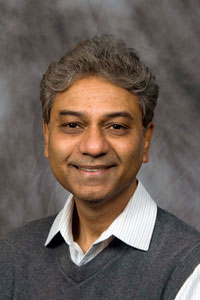
Arun Saha
Physics Division staff scientist Arunava "Arun" Saha, 62, long-time Physics Division staff scientist, passed away during the early hours of May 9 due to complications from recent heart surgery. He is missed by his many colleagues, friends and associates, who remember both his kind and gentle spirit and his many contributions to nuclear physics. He is recognized world-wide as a leader in the study of nuclear structure through experiments in which protons are "knocked out" from nuclei using electron beams. He led these studies over a broad range of nuclei, from the simplest system, the deuteron, to one of the heaviest, the lead nucleus. Saha worked closely with scientists scattered all over the world, and co-authored many publications with them. He was also highly appreciated in the accelerator physics community for his technical expertise in beam line instrumentation. He became part of the JLab (then CEBAF) community in February 1987. Family members held a memorial service at his house on May 11. Saha is survived by his five children, four siblings and his father. He received his bachelor's degree from Fergusson College in Pune, India, and his master's degree from the Indian Institute of Technology in Bombay; then continued his education in the U.S. and earned his Ph.D. in physics from Northwestern University. He was active in the Indian community of Hampton Roads and served as treasurer and subsequently the president of the Asian Indians of Hampton Roads. |
|
The On Target newsletter is published monthly by the Thomas Jefferson National Accelerator Facility (Jefferson Lab), a nuclear physics research laboratory in Newport News, Virginia, operated by Jefferson Science Associates, LLC, for the U.S. Department of Energy's Office of Science. Possible news items and ideas for future stories may be emailed to jlabinfo@jlab.org, or sent to the Jefferson Lab Public Affairs Office, Suite 15, 12000 Jefferson Avenue, Newport News, VA 23606
|


 Ancient glaciers, which have long held secrets about early history, could someday reveal their stories to scientists armed with ultraviolet rays......
Ancient glaciers, which have long held secrets about early history, could someday reveal their stories to scientists armed with ultraviolet rays...... Computational power from facilities at three U.S. Department of Energy national laboratories is aiding Japan's physicists in their quest to understand the interactions that lie at the heart of matter.....
Computational power from facilities at three U.S. Department of Energy national laboratories is aiding Japan's physicists in their quest to understand the interactions that lie at the heart of matter..... More than 2,000 physicists have conducted research at Jefferson Lab through the years, slowly adding to mankind's knowledge of the smallest building blocks of the visible universe......
More than 2,000 physicists have conducted research at Jefferson Lab through the years, slowly adding to mankind's knowledge of the smallest building blocks of the visible universe......